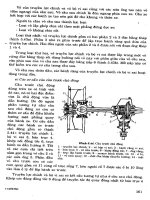McGraw-Hill Build a Remote Controlled Robot Part 1 potx
Bạn đang xem bản rút gọn của tài liệu. Xem và tải ngay bản đầy đủ của tài liệu tại đây (266.69 KB, 15 trang )
BUILD A
REMOTE-
CONTROLLED
ROBOT
Other TAB Electronics Robotics Titles
The Robot Builder’s Bonanza, Second Edition, by Gordon McComb
Robots, Androids, and Animatrons, Second Edition, by John Iovine
TAB Electronics Build Your Own Robot Kit by Myke Predko and Ben Wirz
McGraw-Hill
New York • Chicago • San Francisco • Lisbon • London • Madrid
Mexico City • Milan • New Delhi • San Juan • Seoul
Singapore • Sydney • Toronto
BUILD A
REMOTE-
CONTROLLED
ROBOT
DAVID R. SHIRCLIFF
Copyright © 2002 by The McGraw-Hill Companies, Inc. All rights reserved. Manufactured in the
United States of America. Except as permitted under the United States Copyright Act of 1976, no part
of this publication may be reproduced or distributed in any form or by any means, or stored in a data-
base or retrieval system, without the prior written permission of the publisher.
0-07-140964-5
The material in this eBook also appears in the print version of this title: 0-07-138543-6
All trademarks are trademarks of their respective owners. Rather than put a trademark symbol after
every occurrence of a trademarked name, we use names in an editorial fashion only, and to the benefit
of the trademark owner, with no intention of infringement of the trademark. Where such designations
appear in this book, they have been printed with initial caps.
McGraw-Hill eBooks are available at special quantity discounts to use as premiums and sales pro-
motions, or for use in corporate training programs. For more information, please contact George
Hoare, Special Sales, at or (212) 904-4069.
TERMS OF USE
This is a copyrighted work and The McGraw-Hill Companies, Inc. (“McGraw-Hill”) and its licensors
reserve all rights in and to the work. Use of this work is subject to these terms. Except as permitted
under the Copyright Act of 1976 and the right to store and retrieve one copy of the work, you may not
decompile, disassemble, reverse engineer, reproduce, modify, create derivative works based upon,
transmit, distribute, disseminate, sell, publish or sublicense the work or any part of it without
McGraw-Hill’s prior consent. You may use the work for your own noncommercial and personal use;
any other use of the work is strictly prohibited. Your right to use the work may be terminated if you
fail to comply with these terms.
THE WORK IS PROVIDED “AS IS”. McGRAW-HILL AND ITS LICENSORS MAKE NO GUAR-
ANTEES OR WARRANTIES AS TO THE ACCURACY, ADEQUACY OR COMPLETENESS OF
OR RESULTS TO BE OBTAINED FROM USING THE WORK, INCLUDING ANY INFORMA-
TION THAT CAN BE ACCESSED THROUGH THE WORK VIA HYPERLINK OR OTHERWISE,
AND EXPRESSLY DISCLAIM ANY WARRANTY, EXPRESS OR IMPLIED, INCLUDING BUT
NOT LIMITED TO IMPLIED WARRANTIES OF MERCHANTABILITY OR FITNESS FOR A
PARTICULAR PURPOSE. McGraw-Hill and its licensors do not warrant or guarantee that the func-
tions contained in the work will meet your requirements or that its operation will be uninterrupted or
error free. Neither McGraw-Hill nor its licensors shall be liable to you or anyone else for any inac-
curacy, error or omission, regardless of cause, in the work or for any damages resulting therefrom.
McGraw-Hill has no responsibility for the content of any information accessed through the work.
Under no circumstances shall McGraw-Hill and/or its licensors be liable for any indirect, incidental,
special, punitive, consequential or similar damages that result from the use of or inability to use the
work, even if any of them has been advised of the possibility of such damages. This limitation of lia-
bility shall apply to any claim or cause whatsoever whether such claim or cause arises in contract, tort
or otherwise.
DOI: 10.1036/0071409645
abc
McGraw-Hill
To my wife, Raye, and my children, Daniel, Haley,
Ian, Margaret, and Raymond, for their support
and encouragement.
ABOUT THE AUTHOR
David Shircliff is a teacher at Seneca Ridge Middle School
in Loudon County, Virginia, where he teaches classes in
technology education. A dedicated electronics enthusiast,
Mr. Shircliff has been researching and building robots for
over 20 years.
Copyright 2002 The McGraw Hill Companies, Inc. Click Here for Terms of Use.
vii
CONTENTS
Preface ix
Introduction xi
CHAPTER ONE. THE MOTORIZED PLATFORM 1
Preparing Motorized Wheels 1
The Platform 4
Mounting Wheels 6
Third Castor Wheel 9
Finishing Touches 11
CHAPTER TWO. BODY FRAMEWORK 13
Cutting Aluminum 13
Drilling and Cutting the Sections 15
Assembling Framework 30
Mounting Framework on the Platform 34
Mounting the Vacuum Outlet 35
CHAPTER THREE. POWER SUPPLY AND
TEMPORARY CONTROL BOX 39
Mounting Batteries and Barrier Strips 39
Wiring Platform 43
Temporary Control Box 45
Control Box Construction 48
Wiring the Temporary Control Box 48
Using the Control Box 51
Copyright 2002 The McGraw-Hill Companies, Inc. Click Here for Terms of Use.
For more informatiom regarding this title, click here
CHAPTER FOUR. REMOTE CONTROL SYSTEM 53
Motherboard 57
Wiring the Motherboard 60
Completing the Motherboard 62
Installing and Wiring the Motherboard 63
Using the Remote Control System 66
CHAPTER FIVE. ARMS AND SUBSYSTEMS 67
Arms 69
Drink Dispenser 75
The Head 80
Wiring the Vacuum System 81
CHAPTER SIX. SKIN AND FINISHING TOUCHES 85
Skin 85
Mounting Tray 91
Mounting Controls 92
Body Lights and Horn 96
12-Volt Power Outlet 98
Bow Tie 98
Painting and Trimming the Body 100
Trim 100
Sources 107
Index 111
viii
CONTENTS
PREFACE
I
n recent years robots have captured the interest of more and
more people. Thanks to movies and TV, the notion of the
robot as a mechanical companion and servant has become a
common concept. As interest in robots grew, a number of
books showing how to build robots at home began to appear.
These books, however, were very technical, showing how to
build computer-controlled mobile platforms that are consid-
ered by most to be true robots.
My interest in robots leaned more toward the popular con-
cept of robots as humanlike friends and servants. I did not
have the technical skill or funds to build a computer-controlled
robot, so I decided to develop a robot that would fit the popu-
lar image of robots and not be too difficult to complete or
expensive to build. The result was Questor.
While working on Questor, I tried to develop a project that
I, as a beginner, could complete with little technical skill,
using tools I had in my workshop. Also, I wanted Questor to
look and function like a robot butler, a form I felt best fit the
friend/servant theme. For this reason I needed a people-sized
robot that would have great presence. I concentrated more on
form than sophistication to develop an impressive looking, but
relatively simple-to-build, project—a beginner’s project.
Later, when I decided to write a book about the project, I
wanted to avoid weaknesses I found in other how-to robot
books. This book is heavily illustrated, helping to take the
guesswork out of Questor’s construction. Next, the book deals
only with the construction of the robot, and not the theories
on which it is based. This type of information is best derived
from specialty electronics and robotics books. I have included
ix
Copyright 2002 The McGraw-Hill Companies, Inc. Click Here for Terms of Use.
a list of books and magazines that supply information, as well
as other possible sources for robot kits and parts.
It is my hope that you will use this book not only to build
your own version of Questor, but to guide you in creating your
own unique robot. This way your robot will reflect your knowl-
edge and skill as a builder. Also, I hope that your robot will be
used as a test bed for other robotics projects. If you are like
me, once you build your own robot, you’ll always be trying to
improve it.
David R. Shircliff
x PREFACE
INTRODUCTION
O
ne of the first questions you will have to answer when you
say you have your own robot is, “What does it do?” If your
answer (as mine) is, “It rolls around by remote control and
serves drinks” disappoints the questioner, don’t be offended. It
simply means that the person asking the question knows little
about the real world of robotics, the science of robots.
Before you can attempt to explain your answer to the unin-
formed asker, you must know a little about the subject of
robots. Ask yourself, “What is a robot?” The word robot comes
from the Czech word Robota, which means obligatory work or
servitude. The word robot was first used in a Czech play called
R.U.R. (Rossum’s Universal Robots) by Karl Capek. Written in
1921, the play depicts a race of humanoid robots that turn on
their masters and destroy them, a theme that seems always to be
associated with robots. Figure I-1 shows a scene from the play.
The exact meaning of the term robot, even in today’s techno-
logical age, is a matter of debate. Man’s technical prowess makes
the exact meaning elusive: manlike mechanical device; person
working mechanically, without original thought; machine or
device that works automatically. These definitions seem rather
broad and could encompass any number of modern devices from
a dishwasher to a timer-controlled video cassette recorder, with-
out conjuring up the popular Star Wars notion of robots.
A second, more-precise definition is stated by the Robot
Institute of America. It reads: “A robot is a programmable mul-
tifunctional manipulator designed to move material, parts, tools
or specialized devices through variable programmed motions for
the performance of a variety of tasks.”
While more precise, it tends to be narrow and also does not
parallel the popular notion of the mechanical friend everyone
xi
Copyright 2002 The McGraw-Hill Companies, Inc. Click Here for Terms of Use.
would like to have. It applies more specifically to those types of
robots at work in factories all over the world, shown here in
Figs. I-2 through I-4. These assembly line type robots can do
everything from welding a car (then painting it) to assembling
delicate electronics components, all automatically, 24 hours a
day if needed, and without a break. They don’t get sick
(although when they do break down, they can be easily
repaired or even replaced), ask for pay raises, or any pay for
that matter, and can be retrained to do another job in a matter
of minutes by simply changing the job program in their control
computers. If you look again at Figs. I-2 through I-4, you will
see that while the device most certainly looks mechanical, it
does not look like a human. Instead it takes the shape of the
most useful part of the human anatomy, from a robot stand-
point, the arm.
Both these definitions seem to be correct in their specific
case, but there is a middle family between the simple auto-
mated device and the sophisticated computer-controlled
xii INTRODUCTION
FIGURE I-1. The robots of the play R.U.R. (Rossum’s Universal
Robots) attack their human masters. (Courtesy of New York Public
Library at Lincoln Center.)
manipulator. This middle family is that of the show robot or
showbot. Questor, the robot outlined in this book, is a mem-
ber of the showbot family. Figures I-5 through I-8 picture
examples of commercial show robots.
A showbot in most cases has no computer brain. Instead it
is controlled via a remote control system operated by a person
somewhere out of sight. You might have seen or heard of a
INTRODUCTION xiii
FIGURE I-2. An industrial robot. (Courtesy of Cincinnati Milacron.)
xiv INTRODUCTION
FIGURE I-3. Robots are best used for repetitive tasks like stacking. (Courtesy of
Unimation Inc.)
FIGURE I-4. Robots can do light work such as grinding. (Courtesy of Cincinnati
Milacron.)









